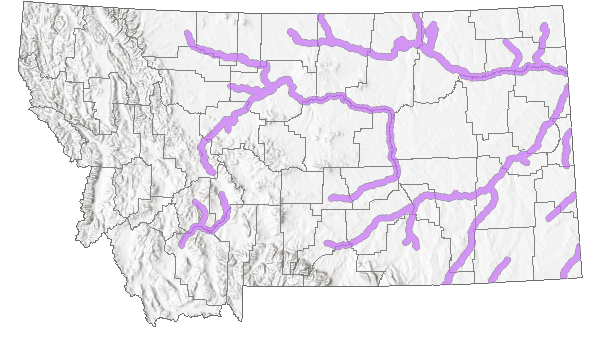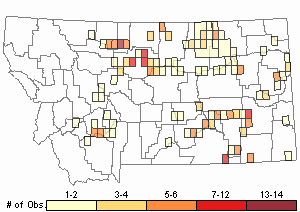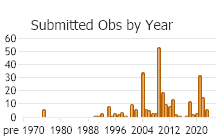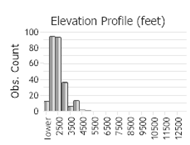View in other NatureServe Network Field Guides
NatureServe
Montana
Utah
Wyoming
Idaho
Wisconsin
British Columbia
South Carolina
Yukon
California
New York
Fatmucket - Lampsilis siliquoidea
Native Species
Global Rank:
G5
State Rank:
S5
Agency Status
USFWS:
USFS:
BLM:
External Links
General Description
The Fatmucket is Montana's most widespread and abundant mussel and is believed to be the most widely distributed mussel in North America. Its native range occurs in areas of the central United States from Montana, the Dakotas, and Nebraska east to New York, and as far south as Louisiana and Mississippi. In Canada, it may occupy areas from the Northern Territories and Alberta to Quebec.
Diagnostic Characteristics
"Shell thick, elongate-ovate, swollen, smooth; yellow to reddish brown; growth lines coarse and rough toward the base; rest scars more or less crowded and varying in conspicuousness; nacre white, pallial line a little channelled anteriorly; one large elevated slightly curving pseudocardinal in one valve, together with a long curving lateral tooth; two triangular pseudocardinals and two sharp-edged curving laterals in the other valve; anterior muscle scars deep; posterior scars scarcely impressed; L. 100, H. 58, D. 37 mm." (La Rocque 1967:226).
Species Range
Montana Range
Range Descriptions

 Native
Native
Range Comments
This species is our largest, native mussel found in the Missouri, Yellowstone and Milk river systems. We have records from Jefferson River above 3-Forks of the Missouri down to Fort Benton and further downstream in the Missouri River to North Dakota. Additionally in the Missouri River Basin, this species occurs in the Marias, Musselshell and Milk Rivers. In the Yellowstone River basin records begin downstream of Billings and proceed to the North Dakota border. Tributaries to the Yellowstone with Fatmucket populations include the Bighorn, Tongue and Powder Rivers. Outside of Montana this is a widespread species in the central and eastern parts of the continent. Burch's range comment indicate that this species extends as far west as Montana and occurs throughout the Missouri/Mississippi River drainage. Burch (1975:20) records the species for the Mississippi drainage from Pennsylvania to Minnesota and south to Oklahoma and Alabama; also in the Canadian Interior Basin in Lake Winnipeg and the Red River systems (Clarke 1973a).
Observations in Montana Natural Heritage Program Database
Number of Observations: 277
(Click on the following maps and charts to see full sized version)
Map Help and Descriptions
Relative Density

Recency



 (Observations spanning multiple months or years are excluded from time charts)
(Observations spanning multiple months or years are excluded from time charts)
Migration
Most dispersal takes places through their host fish, especially the carp. Adult freshwater mussels are mostly sedentary and spend their lives near the area where they first settled as juveniles. They will move short distances (a few meters) during spawning or if prompted by a stimulus such as a water disturbance nearby, exposure due to low water, or seasonal temperature changes. They may burrow into sediments (often doing so in the fall and emerging in the spring) or move away from the area horizontally.
Habitat
The species can be found under a number of conditions but prefers sandy-muddy bottoms and quiet water. Not suited to strong currents or rough bottoms, although it is occasionally found in riffles, most likely from being washed out of calmer pools. It is abundant in quiet water below riffles, with a muddy bottom, and in slowly running water with sand, fine gravel, and mud (La Rocque 1967:226). Clarke (1981:344) indicates the species is abundant and occurs in lakes and rivers of all sizes; it is found on sand, mud, clay and gravel substrates. It is often found in river banks in water as shallow as 5 to 8 cm.
Food Habits
Freshwater mussels are mostly filter-feeders, siphoning in floating particulate organic materials (small plant or animal) from the water column and straining out the particles and expel the strained water. Pedal feeding with the foot muscle has also been observed, mostly in juveniles and younger age-classes.
Ecology
Known native host fish species include Freshwater Drum, Sauger, Sturgeons, Stonecat, Channel Catfish and the introduced species: Carp, Bullheads, Smallmouth Bass, Green Sunfish, White Bass and Yellow Perch
Reproductive Characteristics
"A long-term breeder, with gravid period extending from the first part of August to the middle of the following July. Glochidia are purse-shaped, without hooks, and measure from 0.24 to 0.26 mm in length and 0.26 to 0.30 mm in height. The native host fish include freshwater drum, sauger, channel catfish, stonecat, sturgeons. Introduced fish hosts are: carp, bullheads, centrarchids and yellow perch (Clarke 1981:344).
Stewardship Responsibility
Threats or Limiting Factors
Threats to freshwater mussels and their habitats are thought to include: Pollution, Diversion of rivers for irrigation, hydroelectric and water supply projects, Elimination of natural fish hosts, Eutropification due to agricultural runoff and urbanization
References
- Literature Cited AboveLegend:
 View Online Publication
View Online Publication Burch, J.B. 1975. Freshwater unionacean clams (Mollusca: Pelecypoda) of North America: Biota of Freshwater Ecosystems, Identification Manual No 11. Environmental Protection Agency, Washington, D.C. 176 pp.
Burch, J.B. 1975. Freshwater unionacean clams (Mollusca: Pelecypoda) of North America: Biota of Freshwater Ecosystems, Identification Manual No 11. Environmental Protection Agency, Washington, D.C. 176 pp. Clarke, A.H. 1973. The freshwater molluscs of the Canadian interior basin. Malacologia13(1-2).
Clarke, A.H. 1973. The freshwater molluscs of the Canadian interior basin. Malacologia13(1-2). Clarke, A.H. 1981. The freshwater molluscs of Canada. National Museum of Natural Sciences, National Museums of Canada, Ottawa. 446 pp.
Clarke, A.H. 1981. The freshwater molluscs of Canada. National Museum of Natural Sciences, National Museums of Canada, Ottawa. 446 pp. La Rocque, A. 1967. Pleistocene Mollusca of Ohio. Department of Natural Resources, Division of Geological Survey Bulletin 62, Part 2. 113-365 + 8 plates.
La Rocque, A. 1967. Pleistocene Mollusca of Ohio. Department of Natural Resources, Division of Geological Survey Bulletin 62, Part 2. 113-365 + 8 plates.
- Additional ReferencesLegend:
 View Online Publication
View Online Publication
Do you know of a citation we're missing? Gore, J. A. 1976. In-stream flow requirements of benthic macroinvertebrates in a prairie river. M.A. thesis. University of Montana, Missoula, MT.
Gore, J. A. 1976. In-stream flow requirements of benthic macroinvertebrates in a prairie river. M.A. thesis. University of Montana, Missoula, MT.
- Web Search Engines for Articles on "Fatmucket"
- Additional Sources of Information Related to "Mussels / Clams"





